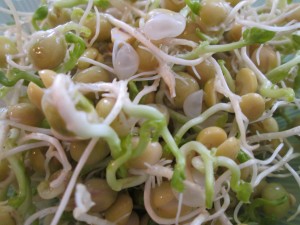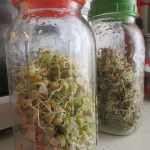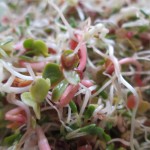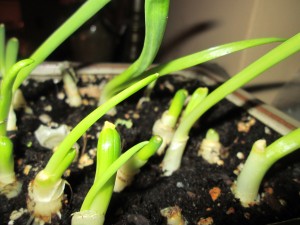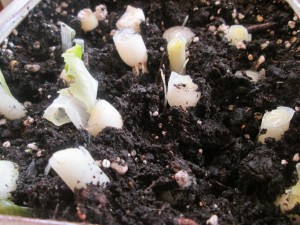The Challenge- Sprouting
I stopped going to the grocery store about 6 weeks ago. Trying to see how long I can hold out. The first month was pretty easy. I knew I was going to do this so I made sure to have fresh produce in addition to what I had in my freezer and pantry. I also had canned and dried a lot of things.
To satisfy my urge for fresh produce I have taken to sprouting. I have a nice assortment of seeds for this purpose and I can start more anytime I like. Because of the variety of seeds that I have I can have sprouts, like pea, garbanzo beans and mung beans that can be eaten cooked or more delicate seeds like alfalfa and radish sprouts that are great as a salad ingredient or on sandwiches. Maybe it is also the time of year, but with snow outside the window the sight of fresh green growth is especially satisfying.
The upside is the seeds last for ages so they will be available for sprouting when I need them. The downside is that it takes a week or more to get sprouts so some planning is required.
Sprouting is pretty simple- although it is a little like having a pet. There is some care than needs to happen. First, start with a clean, wide mouth jar. I have these handy lids with holes in them that are made just for sprouting. Place the seeds in the jars and cover with water. Allow them to be covered in the water for at least several hours. Drain and rinse the seeds. After the first soaking only keep what ever water stays on them after a rinse and drain. That’s pretty much the whole process. Twice a day, maybe three times if the weather is really warm, rinse the seeds and drain off any extra water. Depending on the seeds you can expect your first crop in 7-10 days. You can place the jars in a sunny window for greener sprouts. If you don’t have the lids with holes in them you can cover the jar with some cheesecloth. Hold in place with a rubber band. That will allow the sprouts to get air and make it easy to rinse and drain them.
Sprouts are full of nutrients and can be eaten cooked or raw. In some cases, like with mung beans the skin of the seed will come off after a few days. They tend to float so if you just place the sprouts in a big bowl of fresh water and agitate them. The skins will come to the top and can easily be discarded.
Also, quantity can be tricky. Very few seeds can produce a heck of a lot of sprouts so go easy. A few tablespoons of tiny seeds like radish, alfalfa or broccoli should be plenty. Perhaps a 1/4 cup of larger seeds like the beans and other legumes is also going to give you a bountiful supply. They do take time so if you want a steady supply start a new batch every few days. Once sprouts are the size you want them to be give them a final rinse and drain well. Store in the fridge until you are ready to use them. Do use them soon. Often they are quite perishable. Besides, if you were sprouting for fresh food- enjoy it while it is fresh.
The Challenge- Keeping it Green
Since I am not going to the grocery store these days I am trying to get the most out of what I do have. I had some nice green onions and when I used them rather than tossing the ends into the compost pile I stuck them in a small flowerpot. In less than a week I have lots of new growth and a steady supply of green onions when I need them.
It’s really easy to do. Just get a pot and put some potting soil in it. When you go to use your green onions just cut off the root, leaving about 1/4 inch of the white part. Place in the soil, water and wait. In a week I had some as long as 5 or 6 inches. When you use another onion- just add it to the pot. You can start celery and romaine lettuce pretty much the same way.
The Challenge- Leftover Soup
Since I have made the commitment to not go to the grocery store I have become more aware of wasting food. I try to use as much of what I have and to throw out as little as possible. I am pretty good about using or preserving fresh food. Leftovers can be problematic. I was in the mood for soup last night as the snow flew outside of my window. I had no idea what kind of soup to have so I went looking in my fridge. I had stock but I needed to find something to put in the stock. I managed to find some cooked beans, a little leftover chicken, some pasta and baby bok choy. The end result was a wonderful, satisfying batch of soup. I could never make the exact same thing again, but that is OK. I liked it and the next time I make leftover soup I’ll probably like it, too. I think that may be my weekly routine for a while. I’ll clean out the fridge and use the leftovers to make soup. The nice thing about leftover soup is that the more stuff you have the better it gets.
